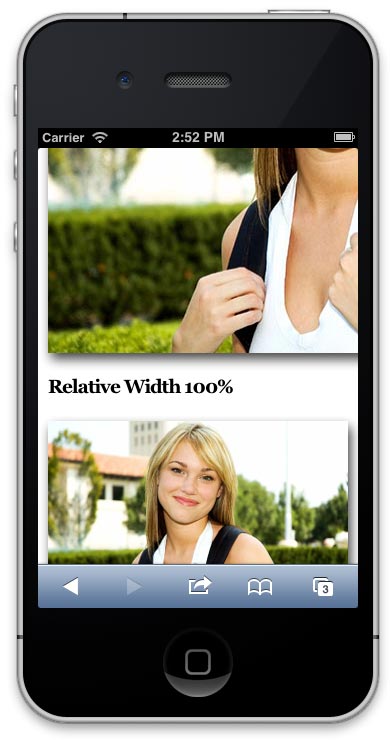 |
| Make Images Scale for Responsive Web Design |
So you have got your web layout flexing and changing layout in a fluid or responsive web layout – but the images are not quite working they are being stubborn and not scaling and moving around like the text!
The reason is because the images most probably have a fixed width which the web layout is honoring, so for example in your source code your image may have a tag like so:
[<img src="images/my-image.jpg" alt="why is my image not scaling" width="590" height="420" />]
So here the image above on a Mobile device in either portrait or landscape orientation will not scale responsively in the view-port at the correct width; for Apples iPhone its view-port is 320px portrait or 480px landscape, so images will display at their fixed size and the user on the mobile device, in the image example above they will have to scroll/swipe to see the full 590px of width – but the idea of responsive layout is to scale all the content into the viewable view port without having to scroll width wise, it’s OK to scroll (swipe) in a depth orientation so the height doesn't really matter.
So how to fix?
Instead of assigning an absolute width value via a HTML attribute in the tag of an image, assign the CSS rule max-width that targets the image as a percentage relative width value like so:
[img {max-width:100%]
What this will do is make the image display 100% of its size within its parent element available width space.
So to illustrate this, below are 2 images of the old favourite parked domain girl, one with a defined width in pixels (590px) the other in a relative width as a percentage (100%).
Fixed Width 590px

Relative Width 100%
scale-image-responsively
Start to make the browser window narrower and watch the bottom image scale and top one remain the same size. The bottom one is scaling to 100% of its parent element which will change depending on the width of the viewport in a responsive design. For a better observation check this page on an iPhone.

So all other elements without a fixed width but rather a relative width will fit to the viewport .

So best practice would be to optimise the image at the largest size required, then set a CSS selector which targets the images and includes the {max-width:100%} rule and also ensure the width attribute is not in the html.
There are some new solutions being considered which serve different size images according to the user agent requesting them however these are not currently supported, this will be a step forward when it is ready as it will cut down on delivering full size images to be scaled on mobile devices.
You may well have a site that is littered with images with fixed widths, here are a couple of solutions to fix those.
Also here is a handy utility to see if your site is acting responsive for tablets and mobile devices.





